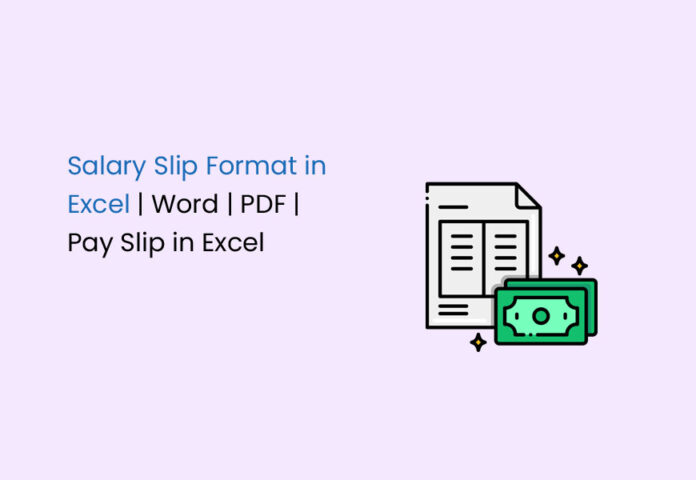Creating salary slips manually for your employees or workers consumes a lot of time and effort. It also comes with the hassle of exhaustion and frustration. Well, look no further! You can now download ready made and customization salary slip templates in Excel, Word, and PDF formats and streamline your payroll process today. That, too, is all for free.
This blog can help and guide you to simplify your payroll management. But before learning how to download the salary slip templates, let us quickly understand the comprehensive meaning of salary slips and their significance to the employees, legal professionals, and even the hiring team.
Read more: Salary Certificate Format: Download word templates
What does a salary slip mean?
Salary slips, often called Payslips, are official document records that provide a detailed breakdown of an employee’s earnings and deductions, allowing them to keep track of their income and tax liabilities.
For employees, a salary slip serves as a legal document and a proof of income, which can be used for various purposes, such as applying for loans or filing tax returns. Moreover, the particulars of a salary slip can help employees make informed decisions about tax-saving investments, such as equity funds, PPF, NPS, and life insurance.
Simple Salary Slip Format Free Download in Excel with Formula, Word, PDF
Our simple guide, Simple Salary Slip Format Free Download in Excel with Formula, Word, PDF, and Google Sheets, can be downloaded and easily kept to track your employee’s income and tax liabilities. So please don’t wait any longer; click the link below and download our templates now!
|
Formats |
Files |
|
Simple Salary Slip Format in Excel |
|
|
Simple Salary Slip Format in Word |
|
|
Simple Salary Slip Format in PDF |
What Are the various components of a Salary Slip?
Grasping the deductions on your salary slip, such as Provident Fund, professional tax, tax deductible at source, and Employee State Insurance, can help you comprehend your overall financial commitments and savings. These deductions create a financial safety net, ensuring access to essential benefits and medical care when you need it the most.
Your salary slip in PDF format that you receive every month is not just a piece of paper to be used for loan applications. It holds utmost importance in various aspects of financial management. It’s essential to understand the financial intricacies within your salary slip so that you can take control of your financial future. By mastering the components of a salary slip, you can make informed decisions on finance and ensure that you are in charge of your earnings and investments.
Here’s the detail about the components of an employee salary slip:
The components of the salary slip can be divided into two parts: Employee Salary and Allowances and the Deductions
1. Employee Salary and Allowances Provided by Company
Basic Salary:
This is the primary component of an employee’s income structure. It constitutes a significant portion of the salary but is taxable. Basic pay is generally higher at entry levels and gradually gives way to other allowances as employees climb the organizational ladder.
Dearness Allowance (DA):
DA is a dynamic component that is directly influenced by the cost of living adjustments due to inflation. It caters to diverse locations and ensures fair compensation relative to the local economic conditions. Although taxable, DA attempts to balance the employee’s purchasing power against rising prices.
House Rent Allowance (HRA):
HRA is designed for employees living in rented accommodations. It provides tax exemptions based on the rent paid, which can be a significant financial relief. The exemptions are governed by specific percentages and rent-payment criteria, enabling employees to optimize tax savings based on living arrangements.
For rented homes, the exemption is 50% (metros) or 40% (others) of Basic. Tax exemption criteria include actual rent paid minus 10% of pay (Basic + DA), actual HRA received, and 50%/40% of (Basic + DA) based on city.
Conveyance Allowance:
Commuting is a daily reality for most employees. Conveyance allowance acknowledges these expenses by offering tax exemptions up to a specific limit. It represents an essential financial relief for many, making their daily journey to work more financially manageable.
The exemption limit is up to ₹ 1600/month or the amount received as earnings.
Medical Allowance:
Medical allowance assists employees in covering medical expenses and catering to their healthcare needs. Tax exemptions are contingent on submitting medical bills, encouraging employees to maintain their overall health and well-being. The allowance underscores the employer’s commitment to employee welfare.
The exemption limit is up to ₹ 15,000/year if proof is submitted.
Leave Travel Allowance (LTA):
LTA is meant to provide tax benefits for employee travel, acknowledging their need for leisure and family time. It fosters a healthy work-life balance and aligns with employees’ travel aspirations, ensuring periodic opportunities for rejuvenation. Its calculation is block-based.
Special Allowance:
Special allowances are designed to act as powerful motivators, encouraging employees to perform well in their roles. Although fully taxable, they signify the organization’s recognition of exceptional performance. These allowances are often tailored to individual job roles, acknowledging and rewarding specific skills and achievements.
Understanding these components sheds light on your salary slip and demystifies the financial intricacies.
CTC:
You need to consider various components to calculate an employee’s cost to the company (CTC). The basic salary is a percentage of the CTC, while the house rent allowance (HRA) is a percentage of the basic salary. The special allowance (SA) is the difference between the CTC and all other allowances. The provident fund (PF) is a percentage of the basic salary, and the gratuity is based on years of service and basic salary. Medical allowances and bonuses could be fixed amounts or percentages of the CTC.
Lastly, there could be other allowances as well. Understanding these components leads to a more productive and successful business.
2. Deductions in Salary Slip Format by Employers
Various deductions are made from employees’ salaries:
Provident Fund (PF):
The Provident Fund (PF) is an employee savings tool managed under the Employees’ Provident Funds and Miscellaneous Provisions Act of 1952. This scheme requires employees to contribute a fixed percentage of their salary, which their employer matches. The contributions form a secure fund that the Employees Provident Fund Organization manages.
Professional Tax:
This is a state-imposed tax levied on all citizens earning income, varying in amount across states. Individuals make a mandatory contribution from their earnings, ensuring financial support for state initiatives.
Tax Deductible at Source (TDS):
TDS represents the amount deducted from a salary at the source of payment. The entity making the payment removes this tax, ensuring compliance with tax regulations. The income recipient is accountable for this tax, streamlining the taxation process.
ESI:
Employee State Insurance (ESI) is a social security scheme that safeguards employees during challenging circumstances. ESI deductions are calculated based on the gross salary paid to employees. According to the ESI Act, the employer contributes 3.25% of the wages, while the employee contributes 0.75% to the contributory fund. This joint contribution creates a financial safety net, ensuring employees have access to essential benefits and medical care when they need it the most.
Gratuity:
It is a monetary benefit provided to employees at the time of their retirement. Companies typically deduct a percentage (4.81%) of an employee’s basic pay.
Importance of Salary Slip for Employees
Your salary slip is more important than you think. Remember to download it every month. Here, learn the significant reasons for the same.
1. Proof of Employment and Salary:
Your salary slip is proof of your employment and salary. It is a legal document containing your name, designation, date of joining, and salary details. You may need to provide your salary slip as income proof while applying for loans, credit cards, or other financial products.
2. Insights into Your Compensation Structure:
Your salary slip provides valuable insights into your compensation structure. It shows the various components of your salary, such as basic pay, allowances, and deductions. Understanding these components can help you assess your take-home pay, tax liabilities, and savings potential.
3. Financial Planning:
Your salary slip is an essential tool for financial planning. By understanding your compensation structure, you can plan your finances effectively. You can set financial goals and allocate your income towards savings, investments, and expenses.
4. Access to Financial Products:
Your salary slip is crucial for accessing financial products such as loans and credit cards. Institutions use it to assess your creditworthiness and determine your eligibility for financial products. Therefore, it is essential to ensure that your salary slip is accurate and up-to-date.
5. Compliance with Legal Regulations:
Your salary slip also ensures compliance with legal regulations. It shows the various deductions made from your salary, such as Provident Fund (PF), Professional Tax, Tax Deductible at Source (TDS), and Employee State Insurance (ESI). Understanding these deductions can help you ensure compliance with legal regulations and avoid any penalties.
Last 3 Months Salary Slip Format
When you’re looking to switch jobs, it’s common for HR to request your previous pay slips, mainly the last three months’ worth. This is because they want to ensure that your current salary falls within the range of what they’re offering for the position.
If your current salary is higher than what they’re offering, they may reject you, while if it’s lower, they may consider offering you a higher designation. Additionally, HR may request your salary slip to verify that you’ve been employed for the last three months and to check your previous background.
They may also want to offer you other compensations or benefits. Remember, HR only needs the last three months’ salary slips, and you can use this sample format to prepare yours. Sometimes, this three-month salary slip format works as a replacement for an experience letter.
|
Sample Salary Slip Format or Pay Slip Format 1 |
|
|
Sample Salary Slip Format or Pay Slip Format 2 |
|
|
Sample Salary Slip Format or Pay Slip Format 3 |
|
|
Sample Salary Slip Format or Pay Slip Format 4 |
|
|
Sample Salary Slip Format or Pay Slip Format 5 |
How To Download Sample Salary Slip from Google Sheets?
If you’re looking for a quick and efficient way to manage tasks like budget tracking or simple project planning, pre-designed formats that require minimal alteration can be very helpful. In such a case, Google Sheets is an excellent tool for collaborative projects, allowing you to work together seamlessly without any headaches. It’s also cost-effective and integrates well with other Google apps, making it the perfect choice for an all-in-one solution.
The following steps will guide you on how to download a payroll template on Google Sheets.
Here are two free payroll templates for Google Sheets; just click on them right away!
- Monthly Payroll Template: Tracks monthly payroll, including hours worked and taxes deducted.
- Annual Payroll Register: Monitors annual compensation and taxes. Both templates are easy to use and can save you time. Download them now!
How to Create a Salary Slip Format for Employees?
To create an employee salary slip, these components and steps are necessary:
Step 1: Open a new spreadsheet.
Step 2: Add the company name and logo at the top of the sheet.
Step 3: In the appropriate fields, enter the employee’s name, ID, department, and job title.
Step 4: Create three columns for earnings, deductions, and net pay.
Step 5: Under the earnings column, list all the allowances, overtime pay, medical insurance, and other benefits the employee is entitled to.
Step 6: Under the deductions column, list all the deferred wages, house rent allowance (HRA), basic pay, and other deductions.
Step 7: Calculate the total earnings and deductions and display them in separate boxes.
Step 8: Subtract the total deductions from total earnings to get the net pay.
Step 9: Display the net pay in a separate box and ensure it is visible.
Step 10: Review the salary slip for accuracy and make necessary adjustments before printing or distributing it to the employee.
Payment Slip Format for Contract Employees
Regarding payment slips for contract employees, it’s essential to include specific details to ensure accuracy and transparency. Contract employees should also receive their salary slips as per Form XIX, which covers salary cycle, nature of work, wage rates, overtime details, gross wage, deductions, and actual salary paid. Here’s a basic format you can use:
- Employee Information
– Full name
– Address
– Social Security Number (SSN)
– Employee ID (if applicable)
- Payment Information
– Pay period dates
– Hourly rate or contract amount
– Total hours worked or project completion percentage
– Gross pay
– Deductions (e.g., taxes, benefits)
– Net pay
- Employer Information
– Company name
– Address
– Employer Identification Number (EIN)
Double-check all information before distributing payment slips to contract employees to avoid any discrepancies or errors.
Advantages of Creating Monthly Pay Slip in Excel
Creating monthly pay slips in Excel has several benefits, as outlined below:
- Easy To Use: Excel allows easy customization of the pay slip to meet the company’s or employees’ specific needs.
- Automated Calculations: Excel provides various tools and formulas for calculating different deductions and taxes, which saves time and reduces errors.
- Electronic Storage: Pay slips can be easily stored and accessed electronically, making tracking and managing employee records more straightforward.
- Cost-effectiveness: Creating pay slips using Excel is more cost-effective than traditional payroll software, which can be expensive to purchase and maintain.
- Professional Look: Excel’s formatting tools can make the pay slip look professional, organized, and easy to read.
- Accuracy: Excel’s built-in functions can help ensure the accuracy of calculations and reduce the risk of errors.
- Flexibility: Excel allows easy updates and modifications to the pay slip template, making it more flexible than traditional paper-based systems.
Salary Slip Format Without Deductions for Salaries below Rs. 3 Lakhs
If you are based in India and reach a salary below Rs 3 lakhs, no deductions will be made. Did you know that earlier?
|
Salary Slip for [Employee Name]
Earnings: Basic Salary: Rs. [Amount] House Rent Allowance: Rs. [Amount] Conveyance Allowance: Rs. [Amount] Medical Allowance: Rs. [Amount] Special Allowance: Rs. [Amount] Gross Earnings: Rs. [Amount]
Deductions: No deductions for salaries below Rs. 3 Lakhs.
Net Salary: Rs. [Amount]
[Company Name] |
Salary slip calculation formula
Here is the formula to calculate salary slip in India,
Net Salary = Gross Salary – Gross Deductions
here,
Gross Salary = Basic Salary + HRA + All types of Allowances + Reimbursements + Arrears + Bonus
Gross Deductions = Professional Tax + Public Provident Fund + Income Tax + Insurance + Leave adjustments + Loan repayments (if any)
Bonus Resources:
- IRS Publication 15 – Circular E, Employer’s Tax Guide: https://www.irs.gov/publications/p15
- National Federation of Independent Business (NFIB) Payslip Template: https://payslipmaker.co.uk/
Conclusion:
In conclusion, the templates provided for salary slips in Excel, Word, and PDF formats highlight the importance of salary slips in workplaces. These templates help streamline salary documentation, ensure adherence to tax regulations, and promote financial transparency.
Ensuring transparency helps in empowering employees to understand their earnings and deductions, facilitating informed financial decisions. Moreover, a detailed salary slip can serve as proof of experience for employees, showcasing their employment history and responsibilities. Thus, these templates serve as valuable tools for both employers and employees, enhancing organizational efficiency and supporting financial literacy.
FAQs on Salary Slip Format
The frequently asked questions on Salary Slip Format are given below:
Are Salary Slips Private?
Salary slips are personal documents. Employers have an obligation to protect their employees’ financial information, ensuring that only authorised personnel and the workers themselves have access to it.
What Should I Do If My Salary Slip Is Incorrect?
To avoid further problems, it is critical to immediately tell your HR or payroll department if you discover any abnormalities or mistakes on your pay statement.
A payslip for an employee can be prepared using software intended specifically for the salary slip. You can, however, create salary slips manually by using an HR/payroll portal.
What is a private employee’s “salary slip”?
A salary slip is an important document that a private employee receives from their employer on a monthly basis. The salary slip serves as documentation of employment for the employee, proving that he or she has been employed by a corporation. In addition, the salary slip shows the employee’s entire or in-hand salary.
Can HR request a salary slip?
Yes, HR can request a salary slip to determine whether or not a particular employee has worked for a company. Also, look at how much the employee is paid.
What information should be included on a salary slip for an organisation?
The organization’s wage slip format should include all employee details, such as name, designation, employee ID, and payment period. Other crucial information on the salary slip should include the gross compensation, deductions, and net salary for the time.
How often should companies give their employees a salary slip?
Organisations must deliver salary slips to employees at least once a month. The organization’s wage slip should include all pertinent information, such as compensation paid, deductions made, number of working days, and so on.
Can companies change the format of their salary slip?
Yes, organisations can tailor their salary slip format to their specific requirements. Even after customisation, the salary should include all of the facts necessary by law, and the wording of the wage slip should be in an easy-to-understand manner.
How can I create a salary slip for the last three months?
Using an online template or a software programme, you can create a salary slip format for the last three months. You may also get free salary slip templates from this link. Some of these programmes allow you to change the format and enter your own data. You can also find simple templates online that you can manually fill out.
What elements should I put in the salary slip format for a Pvt Ltd company?
A salary slip format for a private limited company typically includes the employee’s name and number, the number of hours worked, earnings earned, deductions, any taxes or contributions, and the net compensation amount.
How can I create a simple salary slip?
A simple salary slip can be created using an online template or a software programme. Most of these programmes allow you to customise the format and add the necessary information on the slip. You can also find templates online that you can manually fill out.
What elements should a salary slip format for cash payout contain?
It is critical to include the employee’s name and number, earnings earned, deductions, any taxes or contributions, and the net salary amount when establishing a salary slip format for cash payment. These elements will ensure that the wage slip is correct and that all payments are accurately documented.
How can I obtain my salary slip?
There are several methods for obtaining your salary slip. One of these is to request your salary slip from your company’s human resources department. Another option is to go through your bank. They can supply you with a wage slip because your salary is instantly credited to your bank account.
Can I make or design my own salary slip?
Making your own salary slip is unlawful. Employees cannot design their own salary slips because they are generated by the company. Businesses and organisations can create salary slips using both manual and online techniques.
Should I design a salary slip format for a small business?
Yes, adopting a salary slip format for a small organisation is advised because it aids in ensuring correctness and transparency when paying employees’ salaries. Furthermore, the salary slip can assist with tax calculations and legal compliance.
Where is a salary slip required?
A pay or wage slip is a vital legal document that proves you are a salaried employee. Salary slips are required in a variety of situations, including when applying for new jobs, by banks when taking out loans, by credit card firms, by income tax agencies, and many more.











